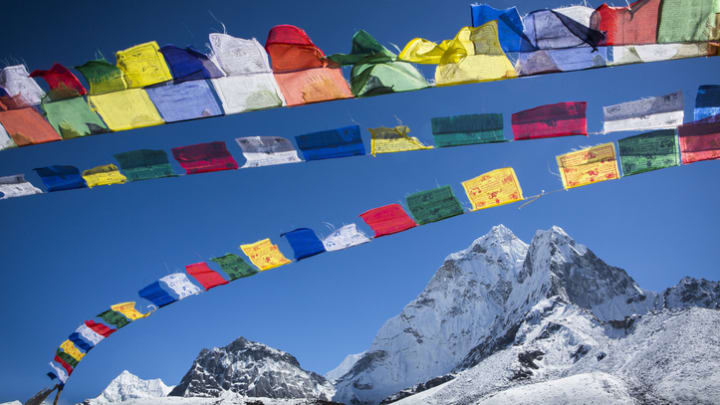Mount Everest: The World’s Highest Graveyard

Climbing Mount Everest, the world’s tallest mountain (as measured from sea level), is one of the greatest physical accomplishments humans can achieve. The bitter temperatures, unpredictable weather, icy terrain, and lack of oxygen make it so difficult, in fact, that many don’t survive to tell the tale. And most of the climbers who didn’t make it are still on the mountain.
Everest’s bodies are now grim landmarks for the adventurers who follow in their footsteps.
The Everest Death Zone
A majority of the dead climbers who remain on the mountain lie within the Mount Everest death zone, the portion of the peak above 8000 meters (26,246 feet). Atmospheric oxygen is so thin at that altitude that climbers routinely carry bottles of oxygen with them (though some climbing purists argue that using supplemental oxygen is akin to cheating). The bottles, however, are heavy and expensive, and climbers have only recently begun to carry their empties down the mountain rather than leave them in piles of litter.
Even with bottled Os, every movement in the Everest death zone can be a life-or-death challenge. Any extra effort to help someone in trouble can put more people’s lives in danger. Using up precious resources to carry incapacitated climbers out of the death zone and down to a survivable altitude is incredibly dangerous, even for experienced Sherpas. And that’s why most of the bodies of Everest’s victims remain where they fall.
How Many Bodies Are on Everest?
The exact number of Everest bodies is not known. A 2015 BBC article estimated that the bodies of more than 200 of the 300-plus people who have died on the mountain are still there. Many are in plain sight of climbers making their way to the summit—tragic reminders of the dangers of their ascents.
Some have even become parts of Everest lore. A fallen figure known as Green Boots, who is believed to be Indian climber Tsewang Paljor (or his teammate, Dorje Morup), perished in the infamous 1996 blizzard recounted in John Krakauer’s bestseller Into Thin Air. The body used to mark a cave along the Northeast Ridge route, but a Chinese team moved it to a less-visible location in 2014. Green Boots is just one of many, though. The historic Northeast Ridge route contains so many bodies still wearing colorful down jackets and climbing gear that the area has earned the morbidly cheerful nickname “Rainbow Valley.”
In 2006, British mountaineer David Sharp collapsed when he ran out of oxygen in the same cave where Green Boots had perished. Some reports say more than 40 other climbers passed Sharp while he was still alive but either didn’t realize he was still breathing or were unable to help him. The tragedy has been a matter of debate ever since.
George Mallory—and Others—on Everest
Also still on Everest: George Leigh Mallory, the English mountaineer who disappeared during the 1924 British Mount Everest Expedition. His body wasn’t found until 1999. The remains of his climbing partner, Andrew “Sandy” Irvine, have never been located.
As the number of Mount Everest climbers has increased over the past 30 years, the number of victims has also grown, with certain days standing out as the most deadly on the mountain. Eight climbers, including Green Boots, never made it back to base camp on May 11, 1996, after the blizzard blew in. On April 18, 2014, an avalanche in the dangerously unstable Khumbu Icefall buried 16 experienced Sherpas who had been preparing fixed ropes for the climbing season. Just one year later, the massive earthquake that struck Nepal triggered an avalanche that swept over Everest Base Camp and killed at least 22 people on April 25, 2015.
Whatever the causes were, one thing is for certain: Many summit hopefuls are still there, eternally caught in the climb.
Read More Stories About Adventure:
manual
A version of this story was published in 2011; it has been updated for 2024.